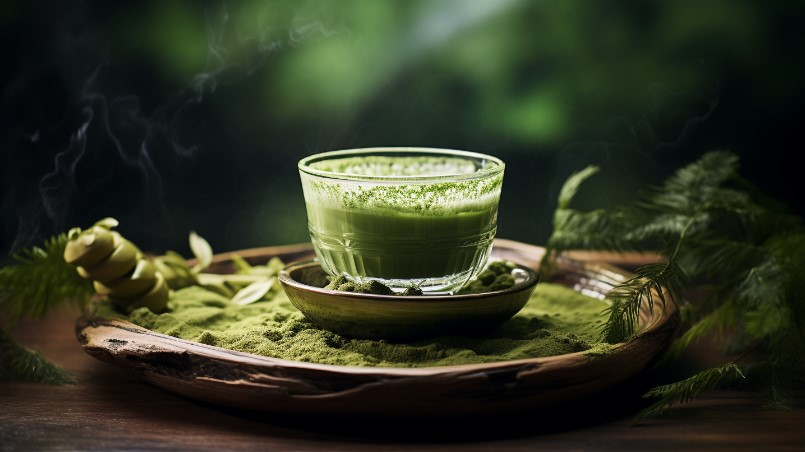Into matcha powder

matcha
Although matcha culture lacks of knowledge popularization in China, matcha culture has been developed in Japan since Tang and Song Dynasties. For a long time, there has been a saying that “the world Matcha is in Japan”, but matcha originated in China.
Matcha originated in China, developed in the Tang Dynasty and reached its peak in the Song Dynasty. As early as the Tang Dynasty, the people invented steaming green loose tea (grinding tea), and also formulated the method of evaluating the color and flavor of tea. Today, the famous Japanese tea ceremony and Japanese matcha are brought back to Japan after learning in China through the ambassadors of the Tang Dynasty. At the beginning of this century, Chinese scholars traveling to Japan brought matcha back to the motherland.
And recipes that include matcha tea have become a trend today. But what is matcha made of? What is this bitter green powder? What are the benefits of it to human health?
What is matcha
Matcha is made by steaming the young leaves of spring tea, making tea cakes (ball tea) for preservation, baking and drying again on the fire before eating, and grinding them into powder with a stone mill. Matcha has high quality requirements for raw materials, requiring the use of tea with high amino acid, protein and chlorophyll content, higher quality than ordinary green tea powder, and is widely used in many fields.
The craft of matcha
The leaves that are dried after the tea is covered are the raw materials of matcha, which is called “rolling tea” in the industry. Rolling tea is already the initial product of tea, and the subsequent grinding process is a deep processing.
Therefore, the two major processing processes of matcha tea are grinding and grinding.
Health Benefits of Matcha tea
The leaves that are dried after the tea is covered are the raw materials of matcha, which is called “rolling tea” in the industry. Rolling tea is already the initial product of tea, and the subsequent grinding process is a deep processing.
Therefore, the two major processing processes of matcha tea are grinding and grinding.
Enhance cognition and concentration
Matcha contains high amounts of L-theanine, an amino acid that helps improve memory and concentration by increasing the production of serotonin and dopamine in the brain.
Provides a lot of antioxidants
Matcha is a good source of antioxidants, especially catechins (EGCG), which help fight the harmful effects of free radicals, thereby protecting cells and tissues from damage. It has also been found to help lower inflammation.
Sedative
The L-theanine found in matcha promotes the production of alpha waves in the brain, which helps promote mental relaxation and lower stress levels.
Improves energy levels and endurance
Matcha contains healthy caffeine, which helps boost energy levels and endurance without any adverse side effects.
Detoxify your body
Matcha contains high levels of chlorophyll, which helps flush out heavy metals and toxic chemicals from the body.
Help with weight loss
Matcha can help increase your metabolic rate, allowing your body to burn fat more efficiently. Exercising immediately after drinking matcha tea can increase fat burning rate by 25%.
Strengthen the immune system
In addition to being rich in antioxidants and theanine, matcha also contains small amounts of vitamins and minerals. Overall, matcha can help boost your immune system and protect your body from bacterial infections and viruses.
Eye protection
The catechins in matcha may be absorbed by different parts of the eye, reducing the risk of glaucoma and other eye diseases.
Identification of matcha tea
1. Color: The purer the matcha, the greener the color, the higher the grade, and the lower the grade of yellow and green.
2. Fineness: Usually the finer the better, more than 1000 mesh is better.
3. Aroma: The higher the grade of matcha, the more fragrant the aroma, elegant, no impurity.
4. Taste: The higher the grade of matcha, the more refreshing the taste.
Characteristics of matcha application
Step 1: Precipitation
Matcha is physically ground, not an extract, so it is insoluble in water and exists in a suspended state in an aqueous solution. After a period of time (after 1 minute), some matcha will inevitably sink to the bottom. Generally, food additives such as thickening agents and emulsifiers need to be added to reduce the precipitation of matcha.
Step 2 Fade
In the process of making tea food (especially baked food), tea food is very easy to change color, especially the surface, in the high temperature and humidity environment from the original green, dark green gradually into yellow-green, this is because matcha is very easy to oxidize. The color of matcha can be maintained as much as possible by lowering the baking temperature, and vitamins and antioxidants can also be added to protect the color. Therefore, matcha baked goods should be kept in an airtight and dry environment.
matcha Manufacturer /matcha Manufacturers/matcha Supplier /matcha Suppliers/matcha Factory:
www.backvita.com
Email: [email protected]
Phone: +86 (029) 8187 2325
